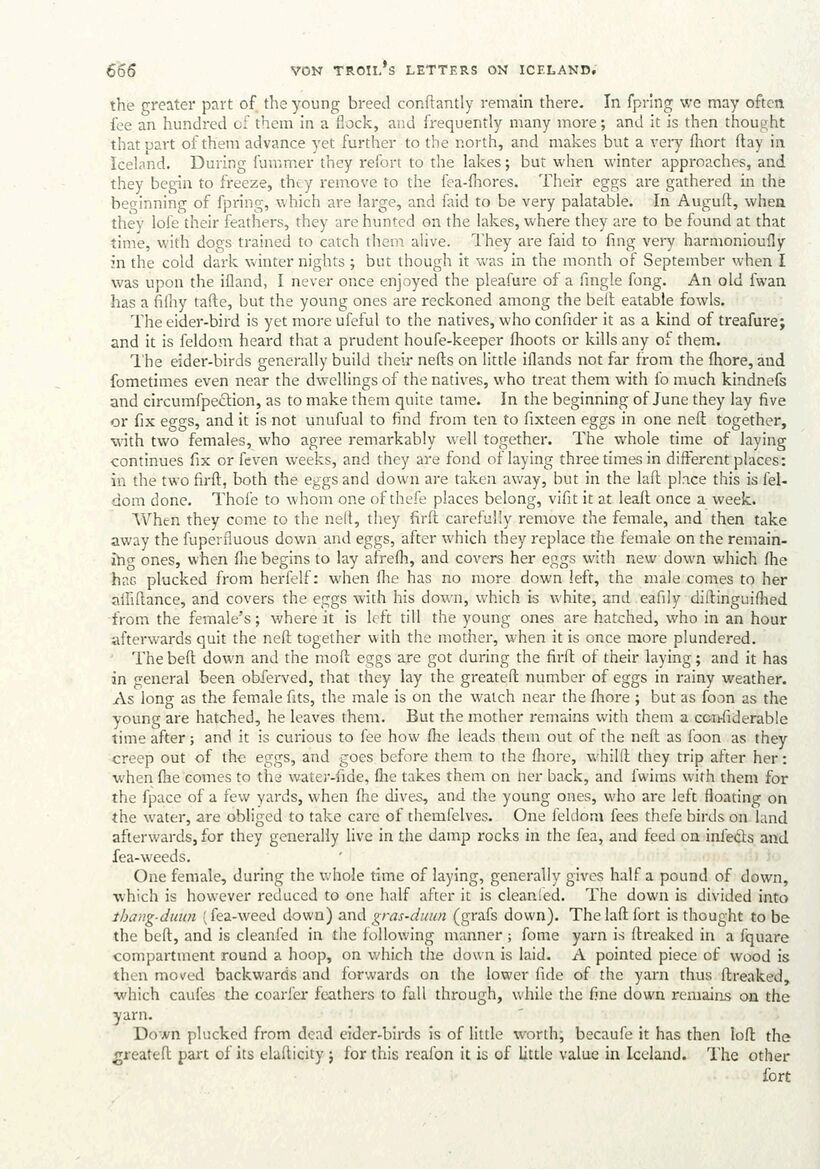
Full resolution (JPEG) - On this page / på denna sida - Pages ...

<< prev. page << föreg. sida << >> nästa sida >> next page >>
Below is the raw OCR text
from the above scanned image.
Do you see an error? Proofread the page now!
Här nedan syns maskintolkade texten från faksimilbilden ovan.
Ser du något fel? Korrekturläs sidan nu!
This page has never been proofread. / Denna sida har aldrig korrekturlästs.
666 VON TROIL’S LETTERS ON ICELAND.
the greater part of the young breed conftantly remain there. In {pring we may often
fee an hundred of them in a flock, and frequently many more; and it is then thought
that part of them advance yet further to the north, and makes but a very fhort ftay in
Iceland. During fummer they refort to the lakes; but when winter approaches, and
they begin to freeze, they remove to the fea-fhores. ‘Their eggs are gathered in the
beginning of fpring, which are large, and faid to be very palatable. In Auguft, when
they lofe their feathers, they are hunted on the lakes, where they are to be found at that
time, with dogs trained to catch them alive. They are faid to fing very harmonioufly
in the cold dark winter nights; but though it was in the month of September when I
was upon the ifland, I never once enjoyed the pleafure of a fingle fong. An old {wan
has a fifhy tafte, but the young ones are reckoned among the belt eatable fowls.
The eider-bird is yet more ufeful to the natives, who confider it as a kind of treafure;
and it is feldom heard that a prudent houfe-keeper fhoots or kills any of them.
The eider-birds generally build their nefts on little iflands not far from the fhore, and
fometimes even near the dwellings of the natives, who treat them with fo much kindnefs
and circum{pection, as tomake them quite tame. In the beginning of June they lay five
or fix eggs, and it isnot unufual to find from ten to fixteen eggs in one neft together,
with two females, who agree remarkably well together. The whole time of laying
continues fix or feven weeks, and they are fond of laying three times in different places:
in the two firft, both the eggs and down are taken away, but in the laft place this is fel-
dom done. Thofe to whom one of thefe places belong, vifit it at leaft once a week.
When they come to the nelt, they firft carefully remove the female, and then take
away the fuperfluous down and eggs, after which they replace the female on the remain-
ing ones, when fhe begins to lay afrefh, and covers her eggs with new down which fhe
has plucked from herfelf: when fhe has no more down left, the male comes to her
afliftance, and covers the eggs with his down, which is white, and eafily diftinguithed
‘from the female’s; where it is left till the young ones are hatched, who in an hour
afterwards quit the neft together with the mother, when it is once more plundered.
The beft down and the moft eggs are got during the firft of their laying; and it has
in general been obferved, that they lay the greateft number of eggs in rainy weather.
As long as the female fits, the male is on the watch near the fhore ; but as foon as the
young are hatched, he leaves them. But the mother remains with them a confiderable
time after; and it is curious to fee how fhe leads them out of the neft as foon as they
creep out of the eggs, and goes before them to the fhore, whilft they trip after her:
when fhe comes to the water-fide, fhe takes them on her back, and {wims with them for
the fpace of a few yards, when fhe dives, and the young ones, who are left floating on
the water, are obliged to take care of themfelves. One feldom fees thefe birds on land
afterwards, for they generally live in the damp rocks in the fea, and feed ominfegts and
fea-weeds. ; 1}
One female, during the whole time of laying, generally gives half a pound of down,
which is however reduced to one half after it is cleanfed. The down is divided into
thang-duun (fea-weed down) and gras-duun (grafs down). The laft fort is thought tobe
the beft, and is cleanfed in the following manner; fome yarn is ftreaked in a fquare
compartment round a hoop, on which the down is laid. A pointed piece of wood is
then moved backwards and forwards on the lower fide of the yarn thus ‘ftreaked,
which caufes the coarfer feathers to fall through, while the fine down remains on the
arn. ,
7 Down plucked from dead eider-birds is of little worth; becaufe it has then loft th
greateft part of its elafticity ; for this reafon it is of little value in Iceland. The other
fort
<< prev. page << föreg. sida << >> nästa sida >> next page >>